If you’re new to this blog, previous posts can be found here
I keep getting asked this by random strangers: What does he do all day? Lots and lots and lots of things…but the one he probably enjoys the most is sailing. It’s something I knew nothing about before I met him. My idea of sailing is being somewhere in the med, hot sunshine, blue seas and flouncing around with a gin and tonic in my hand. Dinghy racing is about as far away from that as you could get!

Himself with his new boat
David’s most recent blog is about his love for sailing. It’s one of the things we do together; well, he does the important sailing bit, I just rig his boat and fling him in it! Now we’re into the sailing season, we’re getting his boat out racing at least once a week, more when we can. He’s pretty damn good at it. In fact, he’s so good that he’s currently the National Champion in his class, he came 2nd in the European Championships last year and in June he’s competing in the World Championships in Holland. I like to think that the only reason he ever actually wins anything is because I am so good at rigging his boat….it’s nothing to do with me, he is in fact very talented and spends a lot of time practising. At our local club, he sails about once a week, and races against the rest of the able bodied sailors. There is a kind of handicap system in dinghy racing, so even though he sometimes finishes last, he actually wins. The club members at Whitefriars are brilliant, someone always helps me get him in and out of his boat and I am forever grateful for their help and support. But we often go away to regattas and events, all over the place. And those days are long and tiring! Yes, I get help; there is a wonderful network of us that traipse around to these regattas and we all help each other out together with the support of the local clubs. I will try and give you some idea of how a typical regatta day works.
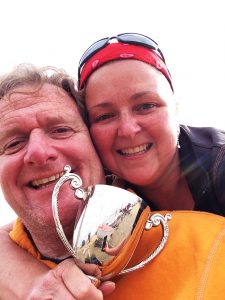
National Champion
Most of us can leap out of bed, fling some clothes on, chug a cup of tea down and be out of the house in minutes if required. It takes on average about 30/40 minutes to get him up, dressed and ready to face the world. But before we can get on our way to a regatta, lots of things need to happen!
Preparation all starts the day before when we go and collect his boat (pictures) from our local club. It needs tying down for transporting (we usually argue about how to tie knots on the trailer ropes), hitching to the car on a trailer; it’s VERY heavy to move about. You can guarantee it will be raining, muddy, windy etc whilst I’m doing this. Get home, make dinner, eat dinner, make sandwiches for the next day, pack bags, fall into bed.
4.30am: time for me to get up and dressed, pack bags in car, feed cats (they’re surprisingly unfussy about time of day!)
5.00am: Get David up and dressed (thermals, sailing trousers, boots…it’s quite a lot of work to get all this onto a fully gown human), fling toast and coffee at him and chuck him in the car to leave by 6am
Arrive at regatta 8.30am: Unpack boat in rain, mud and wind (guaranteed). Rig boat, put sails on 17ft masts, faff about with ropes and pulleys, moan about weather. (There is usually an argument at some point during this process….I don’t always do things the way he wants. But I’m ultimately always right!!)
Get boat on water; boat is even heavier now rigged and needs 2 people to move it. Get David dressed in 6 layers of sailing kit & lifevest and then hoist him into boat. Finish rigging boat, push him off from jetty. Sit down!
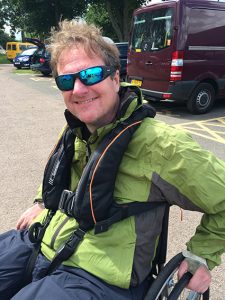
Ready to race
11.30am: Find cake (there is always cake at sailing clubs) and eat cake, chat to the other shore monkeys, moan about our partners/clients/boats/stupid amounts of rope/weather as required.
1pm: Lunch break from racing – hoist David out of boat and remove 6 layers of clothing so that he can move again. Have argument about what I did wrong rigging boat (even though he has usually won both races by now). Begrudgingly find him some lunch.
There is never enough time in the day for all this to happen – some lunch breaks are too short, so he doesn’t bother to even get out of the boat. Getting layers of clothing on and off takes a while, I honestly wonder about wrapping him in a giant roll of bubble wrap some days. It’s warm and waterproof; can’t see how it wouldn’t work!
1.45pm: Put 6 layers of clothing back on him, hoist him back into boat, push him off from jetty. Go and find more cake/check when bar opens.
3.30pm: End of racing, hoist David out of boat and get boat ready to pull boat out of the water (winching up 70kg keel by hand….faffing about with ropes etc). Remove 6 layers of clothing and get him tea and cake. Take boat to pieces again and pack it up. Have an argument about how to tie knots on trailer.
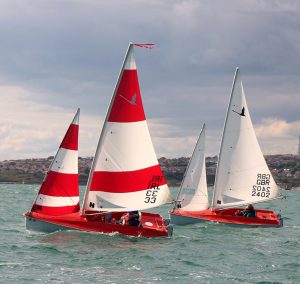
Racing in Portland Harbour
5.30pm: Start journey home
8.00pm: Take boat back to sailing club. Untie things. Gloat about how well my knots held
8.30pm: Arrive home. Get attached by hungry cats. Get David out of car, get bags out of car. Feed cats, feed David. Drink wine whilst discussing racing and brilliance of my knots
9.30pm: Help David into bed. Mention again about how good my knots were
10.30pm: If no further discussion forthcoming re knots, fall into bed
Yes, it’s tiring. So why do I do it? Because I LOVE IT. I’ve learnt to rig his boat on my own and more often than not, I do it right. I can tie knots (see above) and set it up for him to go out and race. You’re wondering how on earth someone who is almost completely paralysed and has little hand and arm function can sail a racing dinghy aren’t you?
These boats are specially adapted so that even someone with the most profound disability can sail them. They have a very heavy keel and are stable so that they can’t capsize, but are also fast in the water and are competitive against racing dinghies that any able bodied person would sail. David competes against anyone and everyone. There are sailors who control their boats by sucking a blowing on a straw; this drives motors to adjust the sails and steering. Others sail with adapted hand controls. David has a stupid looking joystick which we strap to his chest to control the sail position; the steering he does with his hand stuck through a sort of loop – it works!
But the best thing about it is that he can get out there, on the water, in his boat and do something completely independently. Once he’s dressed in 6 layers of clothing and we’ve argued about the knots, he can sail away ON HIS OWN. He doesn’t need me, a carer, a crew – anyone at all. And watching him sail (we are blessed with some very beautiful sailing clubs in this country) is a privilege.
So those are the busy days, they’re long and tiring and can be full of frustrations. Things break, the wind is wrong (too much, not enough), I’ve rigged the boat wrong, he’s sailed it badly… But ultimately we have a great time. I have met lots of people through sailing, made lots of friends, and visited lots of beautiful bits of water all over the place. So the long days are worth it! I hope and pray that the weather Gods are kind to us in Holland; it’s an awfully long way to go for an argument about a few knots!
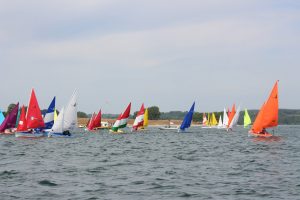
Racing at European Champs
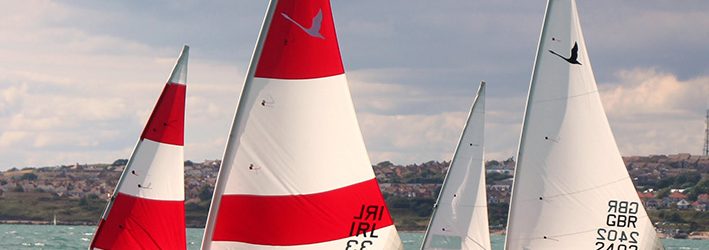
Moan, moan, you womenfolk are always moaning – but we love you and are very glad you are learning how to tie knots.⛵